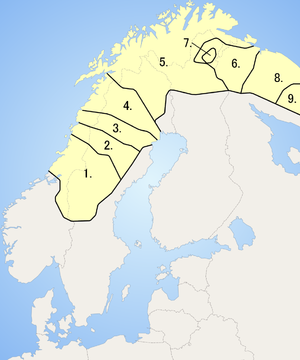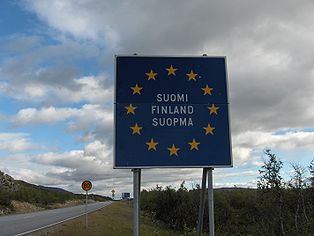- Northern Sami language
-
Northern Sami davvisámegiella / sámegiella Spoken in Norway, Sweden, Finland Native speakers 20,000 (1995) Language family Writing system Latin Language codes ISO 639-1 se ISO 639-2 sme ISO 639-3 sme  Northern Sami is 5 on this map.
Northern Sami is 5 on this map.This page contains IPA phonetic symbols in Unicode. Without proper rendering support, you may see question marks, boxes, or other symbols instead of Unicode characters. Northern or North Sami (Sámegiella or Davvisámegiella, formerly Davvisámi or Davvisaami; disapproved exonym Lappish or Lapp) is the most widely spoken of all Sami languages. The speaking area of Northern Sami covers the northern parts of Norway, Sweden and Finland. The number of Northern Sami speakers is estimated to be somewhere between 15,000 and 25,000. About 2000 of these live in Finland[1] and between 5000 and 6000 in Sweden.[2]
Contents
History
Northern Sami was first described by Knud Leem (En lappisk Grammatica efter den Dialect, som bruges af Field-Lapperne udi Porsanger-Fiorden) in 1748 and in dictionaries in 1752 and 1768. One of Leem's fellow grammaticians was Anders Porsanger, who studied at the Trondheim Cathedral School and other schools, but who was unable to publish his work on Sami due to racist attitudes at the time. Unfortunately, the majority of his work has disappeared.
Roots
The roots of the current orthography for Northern Sami were laid by Rasmus Rask who, after discussions with Nils Vibe Stockfleth, published Ræsonneret lappisk sproglære efter den sprogart, som bruges af fjældlapperne i Porsangerfjorden i Finmarken. En omarbejdelse af Prof. Knud Leems Lappiske grammatica in 1832. Rask felt that the orthography should be based on the principle of one sound–one letter. All of the orthographies that have been used for Northern Sami trace their roots back to Rask's system, unlike the orthographies used for Lule and Southern Sami, which are mainly based on the orthographical conventions of Swedish and Norwegian. Following in the tradition of Rask meant that diacritics were used with some consonants (č, đ, ŋ, š, ŧ and ž), which caused data-processing problems before Unicode was introduced. Both Stockfleth and J.A. Friis went on to publish grammar books and dictionaries for Sami. It can be said that Northern Sami was better described than Norwegian was before Ivar Aasen published his grammar on Norwegian.
Rules
Northern Sami was and is still used in three separate countries, each of which used its own orthography for a number of years. Friis' orthography was used when work on translating the Bible into Northern Sami commenced, in the first Sami newspaper called Saǥai Muittalægje, and in the Finnemisjonen's own newspaper Nuorttanaste. The groundwork for Northern Sami lexicography was laid by Konrad Nielsen who used an orthography of his own creation in his dictionary Lappisk ordbok. Starting in 1948, the orthographies used in Norway and Sweden were combined into a single orthography entitled the Bergsland-Ruong orthography. This orthography, however, was not greatly used in Norway. In addition, the authorities there instituted a policy that prohibited Sami from being used in practice. In Sweden, classes were taught in Sami in the Sami schools, as the policy of Lapp ska vara lapp (Sami should be a Sami) was applied to Sami reindeer herders with the intention of keeping them separated from larger society. In 1979, an official orthography for Northern Sami was adopted for use in Norway, Sweden and Finland.
Assimilation
The mass mobilization during the Alta controversy as well as a more tolerant political environment caused a change to the Norwegian policy of assimilation during the last decades of the twentieth century. In Norway, Northern Sami is currently an official language of two counties (Finnmark and Troms) and six municipalities (Kautokeino, Karasjok, Nesseby, Tana, Porsanger and Gáivuotna (Kåfjord). Sami born before 1977 have never learned to write Sami according to the currently used orthography in school, so it is only in recent years that there have been Sami capable of writing their own language for various administrative positions.
Phonology
Stress
Zero stress can be said to be a feature of conjunctions, postpositions, particles, and monosyllabic pronouns.
Syntax
Northern Sami is an SVO language.
Orthography
Main article: Northern Sami orthographyNorthern Sami has a long orthographic history, which has witnessed no less than 9 different extended versions of the Latin alphabet. The most recent version was approved in 1979 and last modified in 1985:
A a Á á B b C c Č č D d Đ đ E e F f G g a á be ce če de đe e áf ge /ɑ/ /a/ /b/ /ts/ /tʃ/ /d/ /ð/ /e/ /f/ /ɡ/ H h I i J j K k L l M m N n Ŋ ŋ O o P p ho i je ko ál ám án áŋ o pe /h/ /i/ /j/ /k/ /l/ /m/ /n/ /ŋ/ /o/ /p/ R r S s Š š T t Ŧ ŧ U u V v Z z Ž ž ár ás áš te ŧe u ve ez ež /r/ /s/ /ʃ/ /t/ /θ/ /u/ /v/ /dz/ /dʒ/ An acute accent was placed over the corresponding Latin letter to represent the letters particular to Northern Sami (Áá Čč Đđ Ŋŋ Šš Ŧŧ Žž) when typing when there was no way of entering these letters correctly otherwise.[3] These substitutions are still found in books printed after the common orthography was adopted due to system limitations when typing.
Until the official orthography currently in use was adopted in 1979, each country had its own, slightly different standard, so it is quite possible to come across older books that are difficult to understand for people unacquainted with the orthography:
- Maanat leät poahtan skuvllai.
- Mánát leat boahtán skuvlii.
(The children have come to school.)
The first sentence is from Antti Outakoski's Samekiela kielloahpa from 1950; the second one is how it would be written according to the current orthography.
Dialects
Northern Sami can be divided into four major dialect groups: Torne, East Finnmark, West Finnmark (written standard) and Sea Sami.
Grammar
Northern Sami is an agglutinative, highly inflected language that shares many grammatical features with the other Uralic languages. Sami has also developed considerably into the direction of fusional and inflected morphology, much like Estonian to which it is distantly related. Therefore, morphemes are marked not only by suffixes but also by morphophonological modifications to the root. Of the various morphophonological alterations, the most important and complex is the system of consonant gradation.
Cases
Northern Sami has 7 cases in the singular, although the genitive and accusative are identical, so some people might state that it only has 6 cases:
- Nominative
- Genitive
- Accusative
- Locative
- Illative
- Comitative
- Essive
The form taken by the essive (marker: -n) is the same in the singular and in the plural, i.e., mánnán (as a child/as children).
Pronouns
The personal pronouns have three numbers - singular, dual, and plural. The next two tables contain the personal pronouns in the nominative and genitive/accusative cases, respectively.
Nominative singular dual plural English 1st person nom mun moai mii I 2nd person nom don doai dii you (thou) 3rd person nom son soai sii he, she Genitive/Accusative singular dual plural English 1st person gen mu munno min my 2nd person gen du dudno din your, yours 3rd person gen su sudno sin his, her The next table demonstrates the declension of a personal pronoun he/she (no gender distinction) in various cases:
Singular Dual Plural Nominative son soai sii Genitive-Accusative su sudno sin Locative sus sudnos sis Illative sutnje sudnuide sidjiide Comitative suinna sudnuin singuin Essive sunin sudnon sinin Verbs
Person
Northern Sami verbs conjugate for three grammatical persons:
- first person
- second person
- third person
Mood
Northern Sami has 4 grammatical moods:
Grammatical number
Northern Sami verbs conjugate for three grammatical numbers:
Tense
Northern Sami has 2 simple tenses:
and 2 compound tenses:
- Present perfect
- Pluperfect
Verbal nouns
Negative verb
Northern Sami, like Finnish, the other Sami languages and Estonian, has a negative verb that conjugates according to mood (indicative, imperative and optative), person (1st, 2nd and 3rd) and number (singular, dual and plural).
Ind. pres. Imperative Optative Supinum? sg. du. pl. sg. du. pl. sg. du. pl. sg. du. pl. 1 in ean eat 1 - - - 1 allom allu allot 1 aman amame amamet 2 it eahppi ehpet 2 ale alli allet 2 ale alli allet 2 amat amade amadet 3 ii eaba eai 3 - - - 3 allos alloska alloset 3 amas amaska amaset The negative verb in Northern Sami does not conjugate according to tense.
Vocabulary
Cardinal numbers
- nolla - zero
- okta - one
- guokte - two
- golbma - three
- njeallje - four
- vihtta - five
- guhtta - six
- čieža - seven
- gávcci - eight
- ovcci - nine
- logi - ten
- oktanuppelohkái - eleven
- guoktenuppelohkái - twelve
- golbmanuppelohkái - thirteen
- guoktelogi - twenty
- guoktelogiokta - twenty-one
- čuođi - hundred
References
- ^ "Samediggi - Saamelaiskäräjät - Sámi language". http://www.samediggi.fi/index.php?option=com_content&task=view&id=74&Itemid=167. Retrieved 2008-09-21.
- ^ "The Sami dialects". http://www.eng.samer.se/servlet/GetDoc?meta_id=1186. Retrieved 2008-09-21.
- ^ Svonni, E Mikael (1984). Sámegiel-ruoŧagiel skuvlasátnelistu. Sámiskuvlastivra. III. ISBN 9177160088.
External links
- Kimberli Mäkäräinen A Northern Sámi-English vocabulary (5211 words in Sámi as of 13 March 2007)
- Northern Sámi - Inari Sámi - Skolt Sámi - English dictionary (requires a password nowadays)
- Names of birds found in Sápmi in a number of languages, including Skolt Sámi and English. Search function only works with Finnish input though.
- OAHPA! Online interactive Sámi pedagogical program suite
- Sámi language technology project
- Sámi dictionary and terminology database
- Sámi proofing tools project
- Sátnemeahccái project for children
- Gradation described
- Wordlist with sound files
- Gulahalan, a course on North Sámi in Swedish (has sound files)
- Irja Seurujärvi-Kari talks in Northern Sámi
- Lexin picture themes - Northern Sámi
- Sami alphabet - Flash/Sound
Uralic languages Finnic Sami Miscellanea Permic Ugric Samoyedic Italics indicate extinct languagesNewspapers Northern Sámi- Áššu
- Ávvir
- Min Áigi
- Muitalægje
- Nuorttanaste
- Saǥai Muittalægje
- Sámi Áigi
Southern Sámi- Daerpies Dierie
- Waren Sardne
Skolt Sámi- Sää´mođđâz
TV programs Northern Sámi- Ođđasat
- Unna Junná
Periodicals Northern SámiLule Sámi- Samefolket
Radio - NRK Sápmi
- Yle Sámi Radio
- SR Sápmi
Online Inari Sámi- Kierâš
Wikimedia Foundation. 2010.

